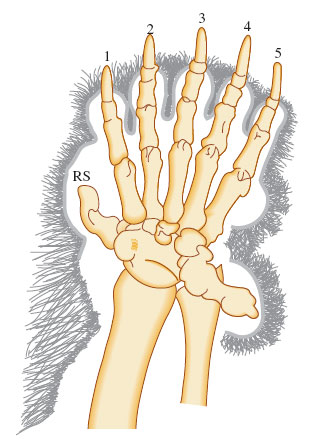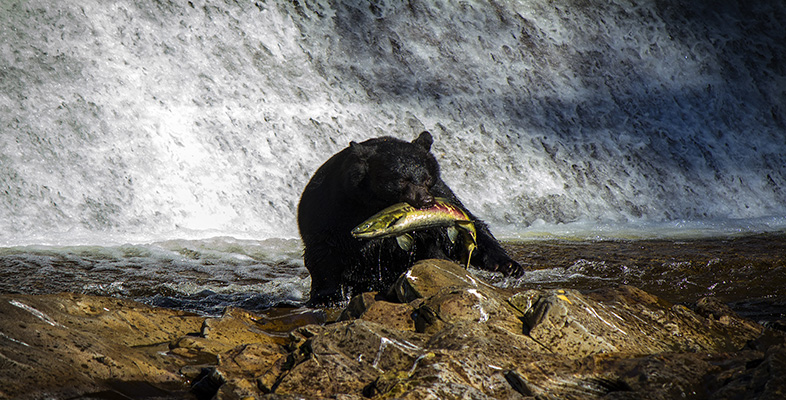4.2 Other members of the bear family
Other omnivorous species of bear include the Asian black bear, the North American black bear and the Andean spectacled bear. Although polar bears spend their winters hunting seals out on the Arctic sea-ice, they have to come ashore when the ice melts in spring and find other sources of food.
Activity 2
Reread LoM p. 165 and make a list of what the polar bear lives on when it is unable to hunt seals.
Answer
Your list should be quite similar to that for the grizzly bear: small mammals, such as ground squirrels and lemmings (though such prey are taken by polar bears very infrequently); vegetation, such as roots and sedges; and fruit, such as blueberries, cranberries and crowberries. Male polar bears will also eat the young of their own species, on the rare occasion they get the chance. (Infanticide is a surprisingly widespread habit amongst mammals. There is more about this in S182_9 Studying mammals: the social climbers.)
The polar bear is strongly specialised to hunting seals and is the only largely land-based animal that does so. You'll know from LoM that there are a few other bears that appear to have travelled down the road of dietary specialisation. While the Malayan sun-bear [p. 165] eats the eggs and nestlings of ground-nesting jungle fowl and the larvae of termites whenever an opportunity arises, it feeds predominantly on fruit - although it also has a penchant for the honey of wild bees. The front claws and snout of the sloth bear are adapted to breaking into termite hills and then sucking up termites - you probably recall the sequence in the TV programme (31.30-32.46) demonstrating (with suitable sound effects) the 'hoovering up' of termites. The lips are large and floppy and two front upper incisors are absent. However, even this degree of specialisation presumably makes the sloth bear less efficient at hunting small mammals or eating vegetation, though it is competent enough at feeding on honey, when it withstands the stings of honeybees to raid honeycombs.
The member of the bear family that has moved furthest from being an omnivore towards having a highly specialised diet is the giant panda.
Activity 3
Watch the TV programme from 00.31-02.18 and also reread LoM p. 156. List the adaptations displayed by the giant panda that allow it to live on a monotonous diet of relatively indigestible bamboo shoots. What are the advantages and disadvantages of this diet for the giant panda?
Answer
Tick off points on your list as you read the following section of text.
The giant panda's molar and carnassial teeth are adapted for crushing and grinding tough, silica-impregnated bamboo shoots. The animal has a large muscular stomach in which it can retain this material for 10 hours to process it further. However, the giant panda's most bizarre adaptation is that which American palaeontologist Stephen Jay Gould wrote about so eloquently in The Panda's Thumb, one of his collections of essays devoted to evolutionary topics:
I was delighted when the first fruits of our thaw with China went beyond ping pong to the shipment of two pandas to the Washington zoo. I went and watched in appropriate awe. They yawned, stretched, and ambled a bit, but they spent nearly all their time feeding on their beloved bamboo. They sat upright and manipulated the stalks with their forepaws, shedding the leaves and consuming only the shoots.
I was amazed by their dexterity and wondered how the scion of a stock adapted for running could use its hands so adroitly. They held the stalks of bamboo in their paws and stripped off the leaves by passing the stalks between an apparently flexible thumb and the remaining fingers. This puzzled me. I had learned that a dextrous, opposable thumb stood among the hallmarks of human success. We had maintained, even exaggerated, this important flexibility of our primate forebears, while most mammals had sacrificed it in specialising their digits …
So I counted the panda's other digits and received an even greater surprise: there were five not four. Was the 'thumb' a separately evolved sixth finger?
(S. J. Gould (1983) The Panda's Thumb: More Reflections in Natural History, pp. 20-21, Penguin Books)
Anatomically, the giant panda's 'thumb' is not a finger at all. During the course of evolution, it was constructed by gradual enlargement of a wrist bone (the radial sesamoid, Figure 4) together with some muscles. It provides an excellent example of pre-existing features becoming adapted, under the influence of natural selection, to serve an entirely different purpose; this is an example of preadaptation.

Bamboo is not very nutritious, though the shoots - which the pandas prefer - contain more nutrients and are more digestible than the mature stems. Giant pandas in the wild have to eat for up to 14 hours a day, consuming 12-38 kg of bamboo (i.e. up to 40% of their body mass).
The very indigestibility of the bulk of the bamboo plant means that only an extreme specialist can utilise bamboo as a food resource - although such a degree of specialisation must make it very difficult (if not impossible) for the animal to make use of any other sort of food. So, the advantage of specialising on bamboo is that the giant panda effectively has almost exclusive use of a food resource that was probably much more abundant in former times.
As you'll recall from LoM [pp. 156-158], the disadvantage is that periodically (between 15 and 120 years, depending on the species) all the plants of any particular species of bamboo flower just once and then die. When this happens, the giant panda has no option but to turn to another species of bamboo until the first has grown again from seed. Before humans reduced the bamboo forests to remnants, the giant panda probably had little difficulty doing this. Today, it cannot migrate in search of a different species of bamboo and consequently it has become a highly endangered species.
As DA writes 'Specialism is a high-wire act - spectacular when it is successful but catastrophic if there is one small failure' [p. 158]. One has to ask, therefore, why one species in an apparently successful family of omnivores turned so emphatically to such an extreme form of dietary specialisation and adaptation that it is now on the verge of extinction. The answer must be that, initially, there was an immediate selective advantage in becoming a specialist bamboo-eater. Only with the benefit of hindsight can it be seen that the giant panda now finds itself in what could be described as an evolutionary cul-de-sac from which it is extremely unlikely to be rescued by the operation of natural selection.
Question 9
Question: There's perhaps a danger of thinking of omnivory as being the ideal 'jack-of-all-trades' feeding tactic, permitting animals to switch from one food source to another as the occasion demands. What disadvantages might omnivory present?
Answer
To complete the familiar epithet, the disadvantage is that omnivores will be 'masters of none'. Being specialised with regard to a particular food generally means that something close to the maximum energetic gain is assured. Of course, the net gain from a meat diet is greater than from an equivalent mass of plant material, but the specialised plant-eaters in course S182_4 generally have adaptations that ensure maximum benefit from their more frugal diet. Mammals that feed opportunistically on plants tend to have a lower trophic efficiency (recall Section 2.1). An example would be the grizzly bears you read about in Section 4.1, which have to compensate by eating substantial amounts of plant material.
As you were reading this section, were there any questions that sprang to mind? For example, did you read the figures about how much bamboo a giant panda eats each day and wonder how much a panda weighs, or ask yourself what percentage of your body mass you eat in food each day? Perhaps you undertook a calculation as follows:
40% of the body mass of the giant panda is 38 kg.
Let's represent the unknown body mass as BM.
40/100 (i.e. 40%) of the BM we know is equal to 38 kg.
Therefore 1/100 (i.e. 1%) of the BM is equal to 38/40 kg.
38/40 kg is equal to 0.95 kg.
Therefore 100% of BM is 0.95 kg × 100, which equals 95 kg.
You could undertake a similar calculation to work out how much food you would have to eat to consume 40% of your body mass per day.
On the other hand, perhaps you wondered about the dentition of giant pandas, or how its thumb evolved, or whether the sloth bears are the same species as the unfortunate 'dancing bears' that are paraded in front of tourists in India, or any of a host of other things. Responding in such a way is an encouraging sign of engagement with the text - you're not simply passively absorbing what you read. Getting involved with the text you read takes practice and requires a good measure of confidence. And finding out for yourself some answers to such questions makes studying more fun, and helps you explore particular aspects that interest you.
